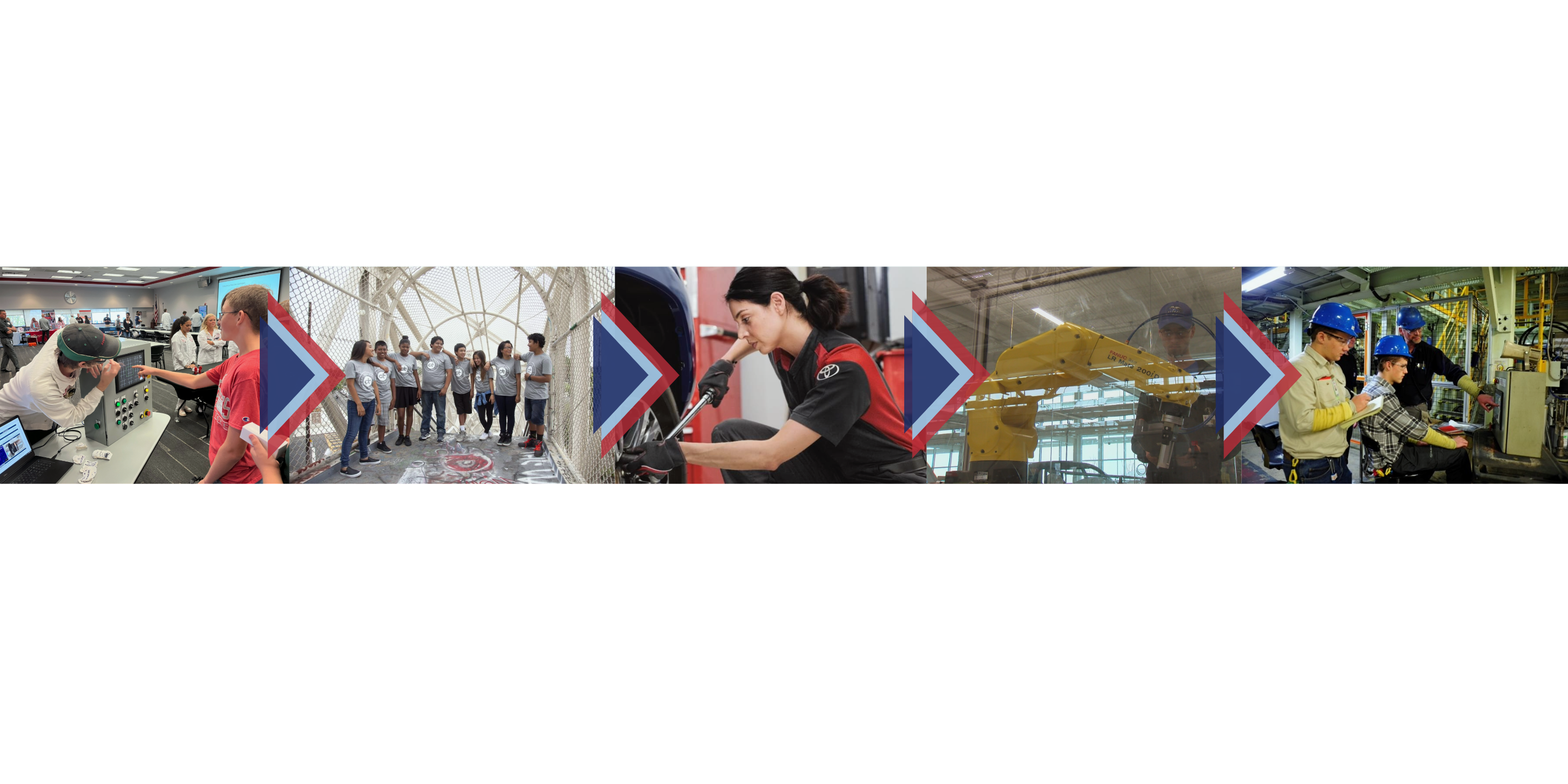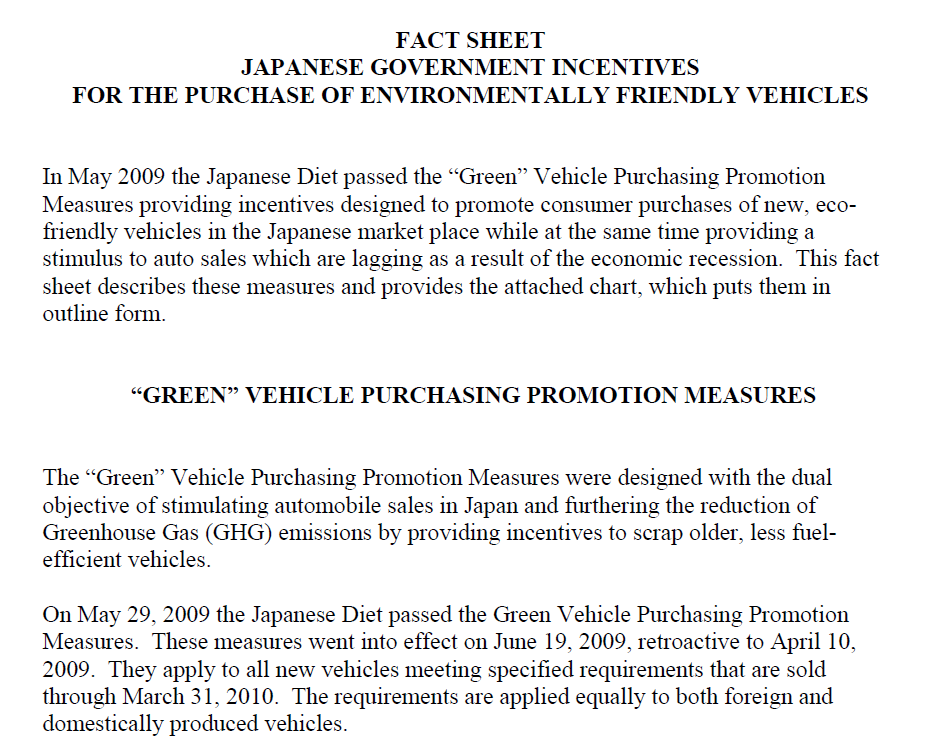In May 2009 the Japanese Diet passed the “Green” Vehicle Purchasing Promotion Measures providing incentives designed to promote consumer purchases of new, ecofriendly vehicles in the Japanese market place while at the same time providing a stimulus to auto sales which are lagging as a result of the economic recession. This fact sheet describes these measures and provides the attached chart, which puts them in outline form.
“GREEN” VEHICLE PURCHASING PROMOTION MEASURES
The “Green” Vehicle Purchasing Promotion Measures were designed with the dual objective of stimulating automobile sales in Japan and furthering the reduction of Greenhouse Gas (GHG) emissions by providing incentives to scrap older, less fuel efficient vehicles.
On May 29, 2009 the Japanese Diet passed the Green Vehicle Purchasing Promotion Measures. These measures went into effect on June 19, 2009, retroactive to April 10, 2009. They apply to all new vehicles meeting specified requirements that are sold through March 31, 2010. The requirements are applied equally to both foreign and domestically produced vehicles.
Details of the Program
The program has two parts: one for consumers who are replacing an older passenger car (“replacement program”) and one for those who are purchasing a new passenger car without an older car to replace (“non-replacement program”). These are summarized in the attached chart.
For those replacing older passenger cars, the vehicle to be replaced must have been first registered 13 years ago or earlier. The replacement model must comply with JFY 2010 fuel efficiency standards. If the replacement model were a standard car or a small car, the consumer would be eligible for a 250,000 Yen ($2,500 at 100 Yen per Dollar) subsidy and if it were a mini-vehicle, the consumer would be eligible for a 125,000 Yen ($1,250) subsidy.
For those purchasing a new passenger car without an older car to replace, the new model must have fuel efficiency at least 15 percent better than JFY 2010 fuel efficiency standards and a four-star emissions performance rating. If the new model were a standard car or a small car, the consumer would be eligible for a 100,000 Yen ($1,000) subsidy and if it were a mini-vehicle, the consumer would be eligible for a 50,000 Yen ($500) subsidy.
Both plans also apply to heavy-duty vehicles, with each of three weight groups of trucks and buses eligible for different yen subsidy amounts.
The Government of Japan has allocated approximately 370 billion Yen ($3.7 billion) for the program, which could lead to the sale of up to 690,000 vehicles.
JAPAN’S FUEL ECONOMY EMISSIONS STANDARDS RELATING TO THE REQUIREMENTS
As the Green Vehicle Purchasing Promotion Measures relate to aspects of Japan’s fuel economy and emissions standards, we are providing a summary below of the relevant portions of the applicable standards and certification requirements relevant to the incentive measures. For further details, please refer to the Motor Vehicle Industry of Japan 2009 Annual Report, or https://www.jama.org/library/brochures2009MIJReport.htm.
The annual report can also be obtained from the JAMA Washington Office on request.
Fuel Economy Standards
The Government of Japan, with the cooperation of its automobile industry, has moved aggressively to control the increase in GHG emissions from automobiles as part of their overall program to meet standards set under the 1997 Kyoto Protocol. As a result, auto manufacturers selling in the Japanese market have steadily increased their fuel economy.
For example, today the passenger car fleet average fuel efficiency exceeds Japan’s fiscal year (JFY) 2010 target of 15.1 km/liter (35.5 mpg). The Government of Japan has set JFY 2015 standards at 16.8 km/liter (39.5 mpg), but, given changes in the test mode, the equivalent km/liter to the old standard amounts to around 19 km/liter (44.7 mpg).
Japan’s fuel economy standards are established and measured on a weight-based class system for passenger cars, which includes most SUVs and minivans, and for heavy-duty vehicles, which includes trucks and buses. Future standards are set on a front-runner basis by which the model with the best fuel economy in a particular class sets the standard for the entire class in future years. Fuel economy performance is strictly monitored and publicized. The Government of Japan issues warnings to those companies which do not meet their fuel economy standards, which, given the environmental consciousness of the Japanese auto consumer, is a strong incentive to meet and even exceed the standards. If a manufacturer were to be given more than two warnings, penalties would be imposed.
Emissions Standards and Certification
In Japan, all vehicles on the road must be certified by the government to meet safety and emissions requirements. Manufacturers have the option to undergo additional emissions certification to achieve superior emissions control status known as the four-star system. To obtain four-star status a vehicle must have emissions levels 75 percent below the 2005 standards. This allows manufacturers to advertise and sell their vehicles under the four star label, which is evaluated highly by the environmentally conscious Japanese auto consumer. 367 of the 827 passenger car models available for sale in Japan in 2008 carried the four-star label, including 310 of the 473 domestic passenger car models and 57 of the 354 imported passenger car models, according to calculations by the Japan Automobile Manufacturers Association based on data from the Japanese Ministry of Land, Infrastructure, Transport and Tourism.
While all vehicles in Japan must be certified for safety and emissions standards, the Government of Japan has established a certification option for low-volume imported vehicles of less than 2,000 vehicles per vehicle type. This certification program, known as the Preferential Handling Procedure (PHP), was established as an alternative to the standard “Type Approval System” procedures in 1986 at the request of the United States Government to ease the burden on importers of the more comprehensive Japanese Type Approval System. This was part of a program to facilitate vehicle imports into Japan.
Japan’s comprehensive Type Approval System for emissions is similar to government certification programs around the world. It includes fuel economy testing and certification as well as emissions testing and certification.
Under the PHP system however, manufacturers are not required, and do not receive, certification for fuel efficiency. Since the Green Vehicle Promotion Purchasing Measures are designed as an environmental improvement program, those manufacturers which do not certify their vehicles either for fuel economy under the Type Approval System or for low emissions under the four-star emission program are not eligible for the program.
VEHICLES ELIGIBLE FOR THE GREEN VEHICLE PROMOTION PURCHASING MEASURES PROGRAM
Based on a review of all models available for sale in JFY 2008, 78.5 percent are eligible for the replacement program and 44 percent are eligible for the non-replacement program. Given the choice of some import manufacturers to certify under the PHP system and not seek four-star status, the percent of import models eligible for the program is estimated at 37 percent by an American Chamber of Commerce in Japan Viewpoint document which lists the Japan Automobile Importers Association as the source for this figure.
Click to view PDF:


